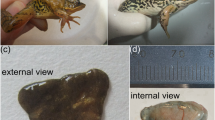Summary
The complicated, bipectinate osphradia of the NeogastropodsBuccinum undatum andNeptunea antiqua are characterized by the following cell types: The columnar supporting cells of the pseudostratified epithelium form the bulk of the epithelial cells and exhibit a profusely developed system of microvilli and an abundance of pigment granules. Occasionaly they are ciliated. At least two types of mucous cells can be distinguished. The different types of sensory cells can be associated with two functions: chemoreception and touch appreciation. An additional sensory cell type with a well developed system of smooth endoplasmic reticulum cannot be related to any particular function.
Zusammenfassung
Die komplizierten, bipektinaten Osphradien der NeogastropodenBuccinum undatum undNeptunea antiqua sind durch folgende Zelltypen gekennzeichnet: Die hochprismatischen Stützzellen stellen den Hauptteil des mehrreihigen Osphradialepithels und sind durch ein reich ausgebildetes Villussystem sowie zahlreiche Pigmentgranula charakterisiert. Bisweilen tragen sie Zilien. Mindestens zwei Schleimzelltypen lassen sich unterscheiden. Den verschiedenen Sinneszelltypen lassen sich zwei Funktionen zuordnen: der Chemorezeption und dem Tastsinn. Die Funktion eines weiteren Typs mit stark ausgebildetem glattem endoplasmatischem Reticulum bleibt unbekannt.
Similar content being viewed by others
Literatur
Altner, H., u.W. Müller: Elektrophysiologische und elektronenmikroskopische Untersuchungen an der Riechschleimhaut des Jacobsonschen Organs von Eidechsen (Lacerta) Z. vergl. Physiol.60, 151–155 (1968).
Andres, K. H.: Der Feinbau der Regio olfactoria von Makrosmatikern. Z. Zellforsch.69, 140–154 (1966).
—: Über die Feinstruktur der Rezeptoren an Sinushaaren. Z. Zellforsch.75, 339–365 (1966).
Bannister, L. H.: The fine structure of the olfactory surface of teleostean fishes. Quart. J. micr. Sci.106, 333–342 (1965).
Bargmann, W., andU. Welsch: On the ultrastructure of the mammary gland (im Druck).
Bernard, F.: Recherches sur les organes palléaux des Gastéropodes Prosobranches. Ann. Sci. nat. (Zool.)9, 89–404 (1890).
Cauna, N., andL. L. Ross: The fine structure of Meissner's touch corpuscles of human fingers. J. biophys. biochem. Cytol.8, 467–482 (1960).
Dakin, W. J.:Buccinum. L. M. B. C. Memoirs 20, London, 115 pp. 1912.
Demal, J.: Essai d'Histologie comparée des organes chémorécepteurs des Gastéropodes. Mém. Acad. roy. Belg.29, 5–82 (1955).
Garnault, P.: Recherches anatomiques et histologiques sur leCyclostoma elegans. Thèse, Bordeaux 1887 (zit. nachStork).
Graziadei, P., andL. H. Bannister: Some observations on the fine structure of the olfactory epithelium in the domestic duck. Z. Zellforsch.80, 220–228 (1967).
Hyman, L. H.: The invertebrates, vol. 6, Mollusca I. New York: McGraw Hill 1967.
Lankester, R.: Mollusca. (Encyclopedia Brittanica 16) 1883 (zit. nachDemal).
Munger, B. L.: A light and electron microscope study, with observations on the nature of Merkel's Tastzellen. J. Cell Biol.26, 79–97 (1965).
Porter, K. R., andE. Yamada: Studies on the endoplasmic reticulum V. Its Form and differentiation in pigment epithelial cells of the frog retina. J. biophys. biochem. Cytol.8, 181–205 (1960).
Reese, T. S.: Olfactory cilia in the frog. J. Cell Biol.25, 209–230 (1965).
Richardson, K. C., L. Jarett, andE. H. Finke: Embedding in epoxy resins for ultrathin sectioning in electron microscopy. Stain Technol.35, 313–323 (1960).
Seifert, K., u.G. Ule: Die Ultrastruktur der Riechschleimhäute der neugeborenen und jugendlichen weißen Maus. Z. Zellforsch.76, 147–169 (1967).
Spengel, J.-W.: Die Geruchsorgane und das Nervensystem der Mollusken. Z. wiss. Zool.35, 333–383 (1881).
Starmühlner, F.: Zur Anatomie, Histologie und Biologie einheimischer Prosobranchier. Öst. zool. Z.3, 546–590 (1952).
Stork, H.-A.: Beiträge zur Histologie und Morphologie des Osphradiums. Arch. néerl. Zool.1, 71–99 (1934).
Wölper, C.: Das Osphradium derPaludina. Z. vergl. Physiol.32, 273–285 (1950).
Yonge, C. M.: The palliai organs in the aspidobranch Gastropoda and their evolution throughout the Mollusca. Phil. Trans. B232, 443–518 (1947).
Author information
Authors and Affiliations
Additional information
Die Untersuchungen wurden mit dankenswerter Unterstützung durch die Deutsche Forschungsgemeinschaft durchgeführt.
Herrn Prof. Dr.A. Kaestner (München) danken wir für Literaturhinweise.
Herrn Prof. Dr.W. Bargmann danke ich für einen Arbeitsplatz im elektronenmikroskopischen Laboratorium des Anatomischen Instituts Kiel.
Rights and permissions
About this article
Cite this article
Welsch, U., Storch, V. Über das Osphradium der prosobranchen SchneckenBuccinum undatum L. undNeptunea antiqua (L.). Z.Zellforsch 95, 317–330 (1969). https://doi.org/10.1007/BF00968461
Received:
Issue Date:
DOI: https://doi.org/10.1007/BF00968461




